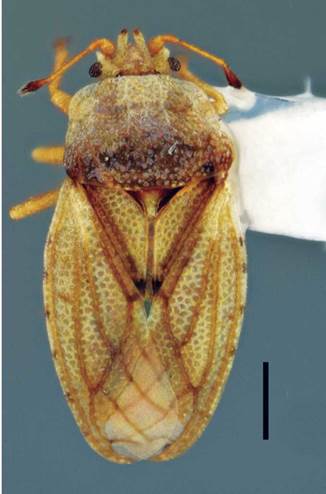Piesmatidae Amyot and Serville, 1843, are a small group of phytophagous hemipterans of cosmopolitan distribution (Drake and Davis, 1958; Brailovsky, 1984). They feed primarily on various species of Chenopodiaceae, but also on Amaranthaceae, Caryophyllaceae, and Fabaceae (Schaefer, 1981). Among Pentatomomorpha, i.e., those Heteroptera with abdominal trichobothria, Piesmatidae can be recognized because they are relatively small (less than 5 mm), dull colored, and have the hemelytra areolate or reticulated (Henry etal., 2015).
The family was thought to be related to Tingidae Laporte, based on the two segmented tarsi and areolate hemelytra, but this was clarified and showed that it belongs not in the Cimicomorpha but in the Pentatomomorpha (Drake and Davis, 1958), where it is now ofplaced within the Lygaeoidea (Henry, 1997).
The family comprises ten genera, two extinct (Eopiesma and Heissiana) and eight extant (Piesmatinae: Afropiesma, Mcateella, Miespa, Parapiesma, and Piesma; Psamminae: Psammium, Saxicoris, and Sympeplus), and about 45 species known worldwide (Slater and Sweet, 1965; Slater, 1970; Henry, 1997; Elias and Cassis, 2012; Henry etal., 2015; Henry, 2017). Recent taxa are most diversified in the Palearctic and Australia, with fewer species in the Western Hemisphere (Drake and Davis, 1958; Elias and Cassis, 2012). Only two genera are present in the New World, Parapiesma and Miespa, the former widely distributed and the latter restricted to Chile. Parapiesma cinereum, the most widespread species, is distributed from Canada to Argentina, but without records from certain South American countries (Drake and Davis, 1958; Dellapé, 2014). Despite being a relatively small group, some species of Piesmatidae are important vectors of virus diseases of some plant crops (Drake and Davis, 1958; Narisu, 2000). The goal of this paper is to record for the first time the family Piesmatidae from Colombia.
Specimens belonging to Piesmatidae were collected in the Department of Sucre, municipality of Sincelejo, at the Universidad de Sucre campus, on May 31st of 2016, by L. E. Salcedo and P. J. Alvarez. The specimens are deposited in the Museo Zoológico de la Universidad de Sucre (MZUSU) and Entomological collection of the Museo Javeriano de Historia Natural de la Pontificia Universidad Javeriana, Bogotá (MPUJ) as follows: MZUSU, 2 ♀♀ (MZUSU-E02676, MZUSU-E02677), 2 ♂♂ (MZUSU-E02678, MZUSU-E02679); MPUJ, 3 ♂♂ (MPUJ_ENT 0064078-MPUJ_ENT 0064080), 3 ♀♀ (MPUJ_ENT 0064081-MPUJ_ENT 0064083). The specimens were determined following Brailovsky (1984) and Drake and Davis (1958). Habitus image was taken at MPUJ with a Nikon D5300 attached to a Nikon SMZ1270 dissecting microscope using a light dome illumination system (Kawada and Buffington, 2016).
South American countries with records of Parapiesma cinereum include Venezuela, Brazil, Paraguay, Uruguay, and Argentina (Drake and Davis, 1958; Dellapé, 2014).
Collected specimens (Figure 1) represent a new country record of Piesmatidae from Colombia.
The specimens were collected in a tropical dry forest in an area with shrubs and herbaceous plants. The specimens were found on Amaranthus dubius (Amaranthaceae); this data is consistent with what has been documented before (Drake and Davis, 1958; Bailey, 1959; Brailovsky, 1984). Piesmatidae species are commonly found on Amaranthaceae, Caryophyllaceae, Chenopodiaceae, Cistaceae, and Fabaceae (Drake and Davis, 1958; Schaefer, 1981; 1983; Narisu, 2000). Some of the specimens were in copula when collected, indicating that A. dubius might be a host plant for this species in Colombia.
Also, in a different collecting event, three complete specimens were found in the gut content of the Rainbow lizard Cnemidophorus lemniscatus (Teiidae). No previous data exist for predators of Piesmatidae, or at least specifically for P. cinereum.
The Colombian record for P. cinereum updates the actual distribution of this species in South America. Further field work on other areas in Colombia will clarify if this species is restricted to the Caribbean coast or if on the other hand can be found in other biogeographic areas.
















